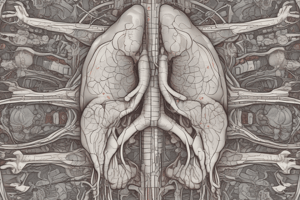Podcast
Questions and Answers
What does the urinary system consist of?
What does the urinary system consist of?
Kidneys, ureters, urinary bladder, urethra
Which system is responsible for the production of hormones?
Which system is responsible for the production of hormones?
- Circulatory system
- Nervous system
- Muscular system
- Endocrine system (correct)
The skeletal system consists of muscles and tendons.
The skeletal system consists of muscles and tendons.
False (B)
What is the anatomical position?
What is the anatomical position?
Which system encompasses the heart and blood vessels?
Which system encompasses the heart and blood vessels?
What is the primary function of the lymphatic system?
What is the primary function of the lymphatic system?
The _______ system consists of the skin and its appendages.
The _______ system consists of the skin and its appendages.
Match the following systems with their primary purpose:
Match the following systems with their primary purpose:
Which anatomical plane divides the body into equal left and right parts?
Which anatomical plane divides the body into equal left and right parts?
The articular system consists of bones and cartilage.
The articular system consists of bones and cartilage.
Flashcards are hidden until you start studying
Study Notes
Urinary System (Urology)
- Comprises kidneys, ureters, urinary bladder, and urethra.
- Responsible for filtering blood, producing, transporting, storing, and excreting urine.
Genital (Reproductive) System
- Divided into gynecology (female) and andrology (male).
- Includes gonads (ovaries and testes) that generate oocytes (eggs) and sperm.
- Consists of ducts for transport and genitalia for union.
Approaches to Studying Anatomy
- Basic Anatomy: Studies minimal anatomy necessary for understanding body functions.
- Regional Anatomy: Examines the body's major parts or segments.
- Surface Anatomy: Focuses on structures beneath the skin and detectable by touch.
- Clinical Anatomy: Explores macroscopic structure and function relevant to medicine.
- Systemic Anatomy: Investigates organ systems working together for complex functions.
Anatomical Position
- Body standing erect, with upper limbs at sides and face, and palms facing forward.
Integumentary System (Dermatology)
- Comprises skin, appendages (hairs, nails, sweat glands), and subcutaneous tissue.
Skeletal System (Osteology)
- Includes bones and cartilage; provides shape, support, and protection for vital organs.
Articular System (Arthrology)
- Consists of joints and ligaments, critical for movement in the skeletal system.
Muscular System (Myology)
- Composed of skeletal muscles for body movement, and smooth/cardiac muscles for fluid control.
Nervous System (Neurology)
- Encompasses central and peripheral systems; regulates organ functions and body responses.
- Integrates sense organs (olfactory, visual, auditory, gustatory) with overall system.
Circulatory System (Angiology)
- Includes cardiovascular and lymphatic systems, transporting body fluids.
Cardiovascular System (Cardiology)
- Comprises the heart and blood vessels; circulates blood delivering oxygen, nutrients, and hormones.
Lymphatic System
- A network of vessels that removes excess tissue fluid (lymph), filters it through lymph nodes, and returns it to the bloodstream.
Anatomical Planes & Terms
- Median Plane: Vertical plane through the body center, dividing into equal left and right.
- Paramedian Plane: Parallel to the median plane, producing unequal left and right segments.
- Medial: Structure located closer to the median plane.
- Lateral: Structure located farther from the median plane.
Studying That Suits You
Use AI to generate personalized quizzes and flashcards to suit your learning preferences.




